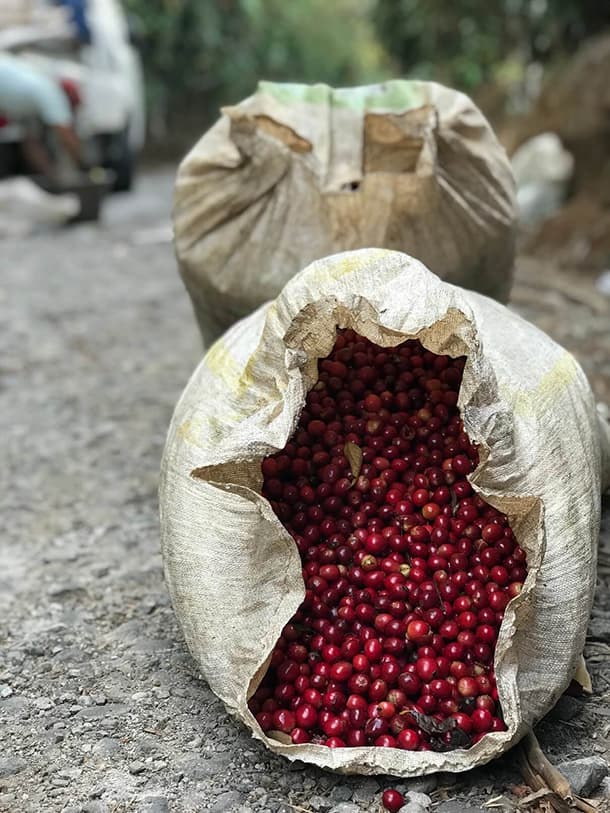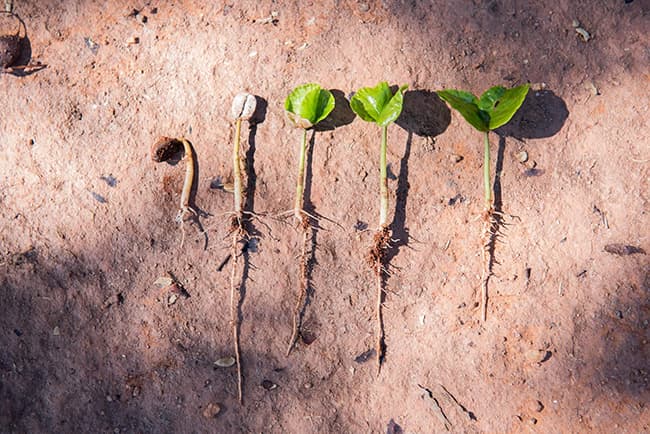
1. Nursery
Getting our soldiers ready ….
Coffee seeds are generally planted in large beds in shaded nurseries. After sprouting, the seedlings are removed from the seed bed and planted in individual pots with carefully formulated soils. They are watered frequently and shaded from bright sunlight until they are hearty enough to be planted permanently outside. Planting takes place during the wet season, month – month (aqui poner cuando es el wet season). This ensures that the soil around the young trees stays moist and allows the roots to be established.
2. COFFEE BLOOM
The flowers of the coffee tree…
The flowers are white with 5 or 6 petals. The pistil that emerges from the cupule, a small, cup-like structure that protects the fruit during its maturation, is tipped with delicate stigmas, which capture pollen and serve as the pollination headquarters. The shape and scent of the flowers resemble jasmine. In the 17th Century, the coffee tree was labeled the “Arabian Jasmine”.
The flowers form glomerules, which are little tufts made up of 8 to 15 elements, at the base of the leaves. They produce the same number of berries, commonly known as cherries because of their color. The flowers last only a few hours and wilt as soon as fertilization has taken place: however, others quickly replace them. As a result, it is not uncommon to find leaves, flowers and berries on the tree at the same time. One tree can produce over 30,000 flowers in a year!
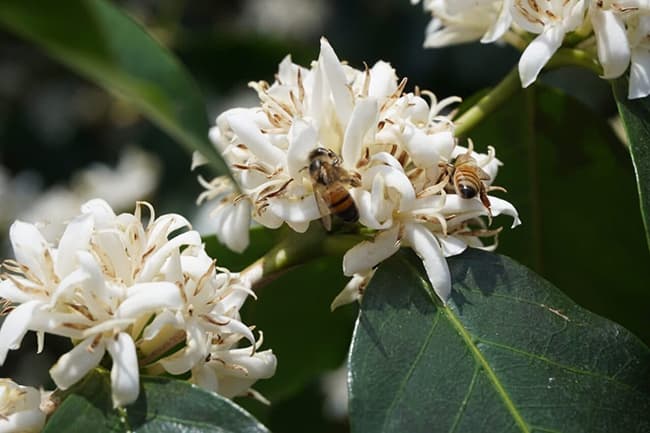
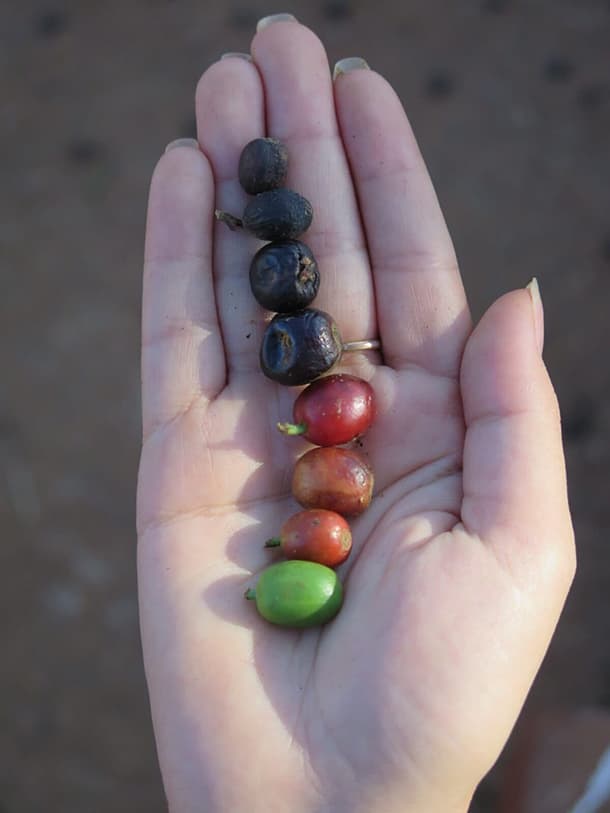
3. CHERRY GROWTH
The berries ripen over several months, becoming successively yellow, then red, garnet red, and finally almost black.
The ideal time for harvesting is when the berries are red. Inside the drupe, protected by the “mesocarp” or pulp, lie two small beans separated by a groove.
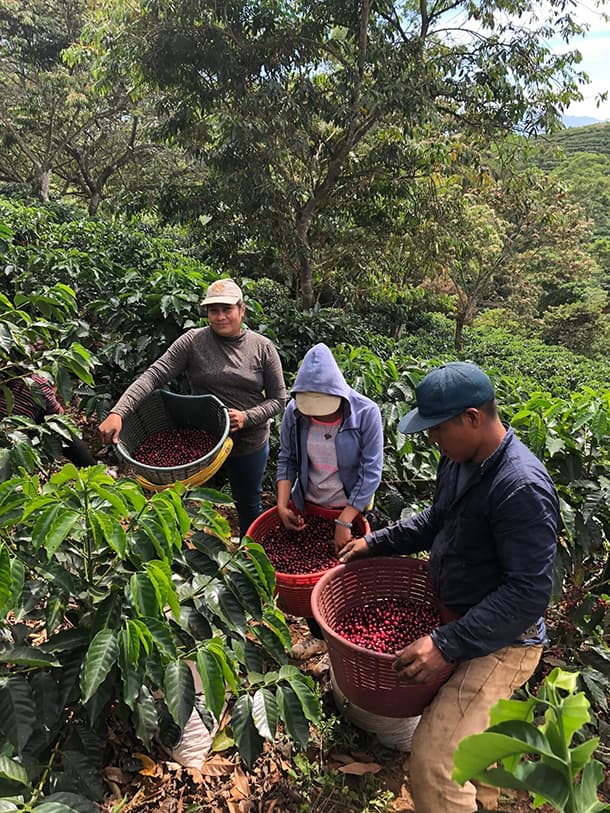
4. HARVESTING
Our cherries are selectively handpicked. Pickers rotate among the trees every 8 – 10 days, choosing only the cherries which are at the peak of ripeness.
5. MILLING AND DRYING
At Hacienda Miramonte we use two different methods for milling.
The Wet Method:
In wet method processing, the pulp is removed from the coffee cherry after harvesting and the bean is dried with only the parchment skin left on. There are several actual steps involved.
First, the freshly harvested cherries are passed through a pulping machine where the skin and pulp is separated from the bean. The pulp is washed away with water, usually to be dried and used as mulch. The beans are separated by weight as they are conveyed through water channels, the lighter beans floating to the top, while the heavier, ripe beans sink to the bottom.
Next they are passed through a series of rotating drums which separates them by size.
After separation, the beans are transported to large, water-filled fermentation tanks. Depending on a combination of factors — such as the condition of the beans, the climate and the altitude — they will remain in these tanks for anywhere from 12 to 48 hours. The purpose of this process is to remove the slick layer of mucilage that is still attached to the parchment; while resting in the tanks, naturally occurring enzymes will cause this layer to dissolve. When fermentation is complete the beans will feel rough, rather than slick, to the touch. At that precise moment, the beans are rinsed by being sent through additional water channels. They are then ready for drying.
The pulped and fermented beans must now be dried to approximately 11 percent moisture to properly prepare them for storage. These beans, still encased inside the parchment envelope (the endocarp), can be sun dried by spreading them on drying tables or floors, where they are turned regularly, or they can be machine dried in large tumblers. Once dried, these beans, referred to as ‘parchment coffee,’ are warehoused in sisal or jute bags until they are readied for export.
Honey Coffee Processing (for microlots)
The other method of milling we use is the honey process. The honey process is an environmentally friendly method of processing ripe coffee cherries.
The basic principle of Honey method lies in picking only perfectly ripe cherries.
At the end of each harvest day, freshly picked cherries are collected, and pulped in manual or electrical pulpers. With their mucilage still fully attached, they are spread on African drying beds. These are raised beds made of wire mesh and black plastic netting (serán).
Depending on weather conditions, the usual drying cycle takes 15-18 days. At the end of this stage, the water content of the beans should be approximately 11%.
The drying of the parchment with all the mucilage still attached has a direct impact on the sweetness of the cup. Honey coffees have a very unique cup profile, characterized by their distinct sweetness, enhanced fruit notes and sweet acidity on the taste and aftertaste.
